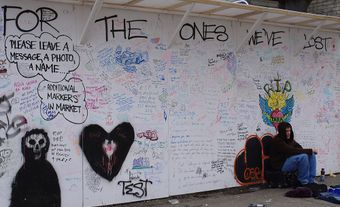This article was originally published in Maclean's Magazine on May 30, 2005
HIV Striking Straight Young Women
KAITLIN MORRISON LOST her virginity at 13 and, she says, "it was downhill from there." At 14, she left her parents' home in Port McNeill, B.C., on the northeast coast of Vancouver Island. She was a "party girl" and a "real rebel," she says, heavy into drugs (never needles, though). Now 23, Morrison recalls how narcotics like cocaine and ecstasy could blunt her judgment, so the sex wasn't always safe. After fleeing an abusive relationship in Calgary, at 19 she returned to Vancouver Island, settling in Port Hardy. She was HIV-free: she'd had herself tested. Then she met "a nice, clean-cut guy" with a good job. They had casual sex. He didn't always wear a condom. "Three days after my 20th birthday," recalls Morrison, "I was diagnosed."
As Ottawa works to develop a new strategy against AIDS, far too many Canadians still think HIV is the bane of gay men and injection-drug users. But the reality is much different, says Barbara Clow, executive director of the Atlantic Centre of Excellence for Women's Health in Halifax. Awareness programs from the early 1990s have actually decreased infection rates among gays and addicts. In contrast, HIV spread by heterosexual contact has risen sharply in Canada, jumping from 11 per cent of new adult cases before 1998 to 33 per cent in 2003.
Part of this new reality is that women - young women in particular - now represent 25 per cent of all new HIV patients, says Clow. That's double the rate from the period before 1997. And roughly two-thirds of these women contracted the virus through unprotected sex with a man.
In a sense, Canada's experience - admittedly in a much smaller way - mirrors that of sub-Saharan Africa, where the disease started off killing men but is now devastating the female population. Today, a startling 57 per cent of adults in sub-Saharan Africa living with HIV or AIDS is female - that's 13.1 million women. In Canada, of about 56,500 people who have tested positive for HIV so far, 14 per cent, or nearly 8,000, are adult females. But the trend line for young, straight women has risen dramatically: before 1994, Canadian females 15 to 29 represented 9.8 per cent of all AIDS diagnoses in their age group; in 2003 the proportion was 41 per cent.
Activists like Clow argue the pattern is evidence Ottawa has already waited too long to come up with an AIDS strategy that targets young women for help. The Public Health Agency of Canada is updating its HIV/AIDS strategy. The release date has been pushed back to sometime this summer, and the agency won't say whether its plan will take direct steps to try to curb the steep rise of HIV in females.
Past experience doesn't bode well. In December, Ottawa pledged $105 million in foreign aid to help protect African and other women from the disease. But changing priorities on the home front have left some groups here frustrated. Carrie McCormack, executive director of Kali Shiva AIDS Services in Winnipeg, recalls that, in 1999, Ottawa gave $24,000 to her support group for HIV-positive women. At the time, they had 13 patients. The annual funding climbed to $35,000 in 2000, but it hasn't budged since, even though the facility now serves 85 women. (Ninety per cent of the clients are Aboriginal, a group disproportionately burdened by the disease.) Instead of addressing the problem, says McCormack, Ottawa is cutting her grant by 11 per cent next year. Her reaction? "I don't think you can print that kind of language."
Poverty, ignorance and social pressure all contribute to the problem that is AIDS. And, despite the warnings, too many teenagers continue to have sex without condoms. Meantime, young women like Morrison have all too quietly become the new face of this deadly disease. Today, she works for AIDS Vancouver Island, running a needle-exchange program and sharing her experiences with teens. She is stunned by how many kids still think HIV/AIDS can be cured. "It makes me sick," says Morrison. "A lack of knowledge is exactly what's going to feed this epidemic." That, and ignoring the fact that young heterosexual women are increasingly at risk.
Maclean's May 30, 2005

 Share on Facebook
Share on Facebook Share on X
Share on X Share by Email
Share by Email Share on Google Classroom
Share on Google Classroom


